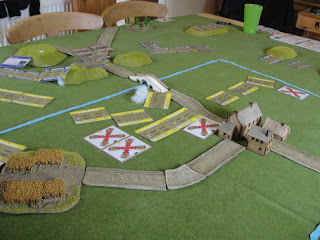French Forces
CinC - Dupont (played by Pendraken Forum Member Paul 'T13a')
I Corps (under Lannes)
1x Elite Infantry, 3x Line Infantry, 1x Heavy Foot Massed Battery
II Corps
1x Elite Infantry (-1 Strength), 3x Line Infantry (1 unit at -2 strength, 2 units at -1 strength), 1x Medium Foot Massed Battery
III Corps
3x French Model Allied Infantry, 1x Allied Cavalry
IV Corps
3x Other Allied Infantry, 1x Poor Cavalry (all units at -2 strength)
Only by defeating the Spanish by nightfall can the French win the campaign.
Left with little choice, General Dupont takes an aggressive stance, ordering I and III Corps to attack West towards C4. II and IV Corps are ordered to support the attack in the West leaving a small reserve to hinder the Spanish reinforcements arriving later in the day at C6.
II and IV Corps will also aim to hold off the Spanish attempting to cross the river in support of their forces in C4.
Spanish Forces
CinC - Castanos (Played by Pendraken Forum Member 'Nosher')
I Corps (under Ballesteros)
3x Regular Infantry, 3x Pronvincial Infantry, 1x Medium Foot Massed Battery
II Corps
3x Regular Infantry, 3x Pronvincial Infantry, 1x Medium Foot Massed Battery
III Corps
2x Elite Infantry, 2x Regular Infantry
Cavalry Corps
1x Heavy Cavalry, 1x Light Cavalry, 2x Irregular Cavalry
+20 points spent on La Guerilla tactics
Recognising their superiority in numbers and in VP's and with the benefit of being able to see the French deployment, the Spanish choose a less aggressive approach.
Ballesteros orders II and III Corps to press forward toward the river bank whilst I Corps hug the same bank forming two sides of a holding box. The aim of the Spanish is to hold until the arrival of the Cavalry Corps and if an opportunity presents itself to take a more aggressive approach by crossing the river to engage the lead French columns.
The Cavalry Corps is to make haste to the battlefield and harass the rear of the French.
 |
| Estacia in the foreground, bordered on three sides by the minor river. The Spanish I Corps can be seen in the NW corner |
 |
| French deployment. I and III Corps positioned to assault the Spanish I Corps supported by II and IV Corps protecting the rear where Spanish reinforcements are likely to approach from at some stage |
 |
| The battlefield viewed from the SW |
 |
| French I Corps advances West whilst the Spanish move up to support their isolated countrymen N of the river |
 |
| Spanish artillery causes the first casualties of the day |
 |
| French forces press forward to skirmish across the river |
 |
| As the volley exchanges continue the Spanish Cavalry Reserve arrives in the NE. The French rearguard prepares for action on the high ground. |
 |
| Casualties mount on both sides as the volley fire duels continue. Restricted by space, the French begin to feel the pressure as more and more Spanish units creep forward to add their weight of fire. |
 |
| Spanish cavalry harass the French on the high-ground as their irregular cavalry make for the French Guns and the rear of IV Corps |
 |
| Spanish Irregulars head for the French artillery and the rear of IV Corps |



No comments:
Post a Comment
Note: only a member of this blog may post a comment.